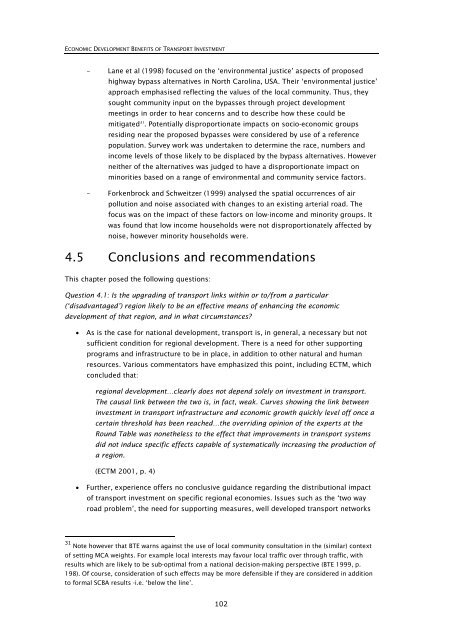Research 350 - NZ Transport Agency
Research 350 - NZ Transport Agency
Research 350 - NZ Transport Agency
You also want an ePaper? Increase the reach of your titles
YUMPU automatically turns print PDFs into web optimized ePapers that Google loves.
ECONOMIC DEVELOPMENT BENEFITS OF TRANSPORT INVESTMENT<br />
– Lane et al (1998) focused on the ‘environmental justice’ aspects of proposed<br />
highway bypass alternatives in North Carolina, USA. Their ‘environmental justice’<br />
approach emphasised reflecting the values of the local community. Thus, they<br />
sought community input on the bypasses through project development<br />
meetings in order to hear concerns and to describe how these could be<br />
mitigated 31 . Potentially disproportionate impacts on socio-economic groups<br />
residing near the proposed bypasses were considered by use of a reference<br />
population. Survey work was undertaken to determine the race, numbers and<br />
income levels of those likely to be displaced by the bypass alternatives. However<br />
neither of the alternatives was judged to have a disproportionate impact on<br />
minorities based on a range of environmental and community service factors.<br />
– Forkenbrock and Schweitzer (1999) analysed the spatial occurrences of air<br />
pollution and noise associated with changes to an existing arterial road. The<br />
focus was on the impact of these factors on low-income and minority groups. It<br />
was found that low income households were not disproportionately affected by<br />
noise, however minority households were.<br />
4.5 Conclusions and recommendations<br />
This chapter posed the following questions:<br />
Question 4.1: Is the upgrading of transport links within or to/from a particular<br />
(‘disadvantaged’) region likely to be an effective means of enhancing the economic<br />
development of that region, and in what circumstances?<br />
• As is the case for national development, transport is, in general, a necessary but not<br />
sufficient condition for regional development. There is a need for other supporting<br />
programs and infrastructure to be in place, in addition to other natural and human<br />
resources. Various commentators have emphasized this point, including ECTM, which<br />
concluded that:<br />
regional development…clearly does not depend solely on investment in transport.<br />
The causal link between the two is, in fact, weak. Curves showing the link between<br />
investment in transport infrastructure and economic growth quickly level off once a<br />
certain threshold has been reached…the overriding opinion of the experts at the<br />
Round Table was nonetheless to the effect that improvements in transport systems<br />
did not induce specific effects capable of systematically increasing the production of<br />
a region.<br />
(ECTM 2001, p. 4)<br />
• Further, experience offers no conclusive guidance regarding the distributional impact<br />
of transport investment on specific regional economies. Issues such as the ‘two way<br />
road problem’, the need for supporting measures, well developed transport networks<br />
31 Note however that BTE warns against the use of local community consultation in the (similar) context<br />
of setting MCA weights. For example local interests may favour local traffic over through traffic, with<br />
results which are likely to be sub-optimal from a national decision-making perspective (BTE 1999, p.<br />
198). Of course, consideration of such effects may be more defensible if they are considered in addition<br />
to formal SCBA results -i.e. ‘below the line’.<br />
102
















